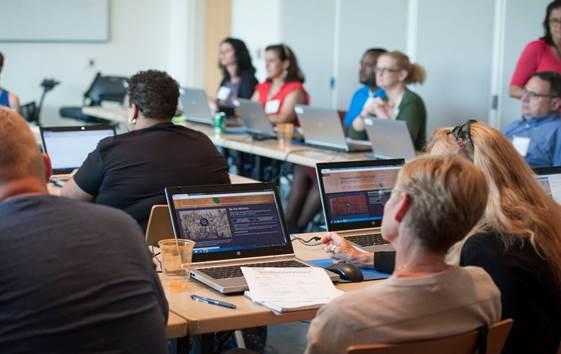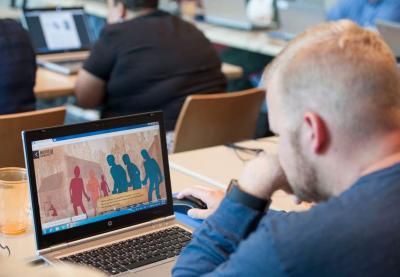The National Museum of the American Indian’s (NMAI) Native Knowledge 360° is a new initiative to help educators teach about American Indians. Misinformation about Native peoples persists in textbooks and teachers lack resources, so the NK360° team “looked for the gaps” as way to fulfill this real need.
Ed Schupman, manager of the Native Knowledge 360° Initiative, gave us the scoop on this interactive teaching resource for educators.
What was the impetus for Native Knowledge 360°?
We looked at 30 different textbooks. It basically comes down to the same eight or 10 stories [that] are in the textbooks; they’re the same stories that have been there for decades. Things like the Cherokee and the Trail of Tears, the Plains Wars, Pocahontas and Jamestown, Thanksgiving, Sacagawea, the Central and South American civilizations of the Maya, Inca and the Aztec—and that’s about it.
These stories are always told in the context of where they intersect with the American story or as the ancient peoples of the Americas. Just people of the past and they tend to focus on things like food, clothing and shelter. They never really get into the richer stories that include Native perspectives that talk about the fact that the American Indian story is America’s story and that there’s 20,000 years of history at least and cultures that really just can’t boil down to those eight or 10 stories. We’d like for NMAI to be one of the leaders in making a national change in how we educate about American Indians.
How did you decide on the Essential Understandings About American Indians?
We were looking for an alternative to those eight to 10 textbook stories that seem to permeate every publisher’s textbook these days. For a model, we looked at, first, what states like Montana had done. Montana had developed its own set of essential understandings, and they met with a group of Native educators and others in the state. And they hammered out seven essential ideas that they thought every kid in Montana ought to know about the Native people.
We said, “How would this apply on a national level?” We looked at the National Council for the Social Studies, 10 themes for their social studies standards. We liked those themes because they’re far reaching, and they get students to think about a broad range of human experience. Things like cultures, time, continuity and change; people, places and environment; individuals, groups and institutions; power, authority governance; production distribution and consumption; science, technology and society; global connection and civic ideals and practices.
[The Essential Understandings] helps people to move from this abstract notion to something tangible.
Have you have piloted any of the NK360° educational materials? And, if so, what are some memorable experiences or responses?
One of the staff writers and I went up to New York, and we did a professional development session for around 20 high school social studies teachers on our removal lesson.
[They were] able to take this content, the voices of Indian people, and integrate it in interdisciplinary ways to their own curriculum. Really committed creative teachers are good at that.
I just got a note from a teacher in Nevada on our removal lesson. He says, “Above all, the lessons are important because of how they organically and continually direct students back to the unit compelling question: ‘What does it mean to remove a people?’ It is this structured focus on a question with enormous political and ethical stakes that makes the American Indian removal lesson sequence a valuable resource.”

What are some teacher-favorite resources?
They like the maps [and] primary sources. We have a website called American Indian Responses to Environmental Challenges. It’s an interactive online lesson that has rich video that we shot in communities. It’s an examination of four case studies of Native American nations in the United States today who are dealing with specific environmental issues.
Another one is Living Maya Time, a website that teaches about Maya culture, both ancient and contemporary. It explores Mayan astronomy and measures the movement of the sun to predict the seasons and looks at the Maya calendar system. It also looks at Maya mathematics and the glyph systems.
What types of challenges have you faced? And what was your response?
The first one is demand on teacher schedules. One of the things that they tell us is, “I would love to teach more about American Indians, but I don’t have the time.” The way that we try to address that is to show them how our resources connect to the curriculum.
Another challenge is our current political climate. You could say we are trying to rewrite history so that it becomes more accurate and so that the country can come to grips, finally, with what it did to Native Americans. This country was built on Native lands and on the backs of slave labor. The country has never come to grips with that, and Native communities are still dealing with the effects.
There’s a lot of positive stories that come from Native America. We certainly don’t just focus on the negative, but it’s important and I think we can become a better country if we look honestly at our history and move forward.
What would you like teachers to know about your Teacher Training Institutes?
We bring teachers in here for a one-week, intensive experience, where we will introduce them to our new resource. They will have an opportunity to hear from scholars who publish and people who are also Native community members. They’ll have an opportunity to see our collection, and they will be able to hear from pedagogical experts.
Our idea behind this model is to develop a network of teachers who will become our best implementers. Our ultimate goal with the institute model is to invite those best users back for a second level of training to become NMAI-certified teachers and trainers. They then become a cohort of teachers who will train in their regions and become advocates for our resources.
What else would you like people to know about Native Knowledge 360°?
We’re just getting started, and I want to encourage the Teaching Tolerance audience to stay in touch with us. Go to our website. We’re going to make it more of a community where we can have teachers sharing resources.
All of these stories—the African American experience, the Hispanic experience, the Native American experience—that is America’s story, and we don’t need to be afraid of that.
Morris teaches writing and Native American/Indigenous Rhetorics at Kutztown University of Pennsylvania.
